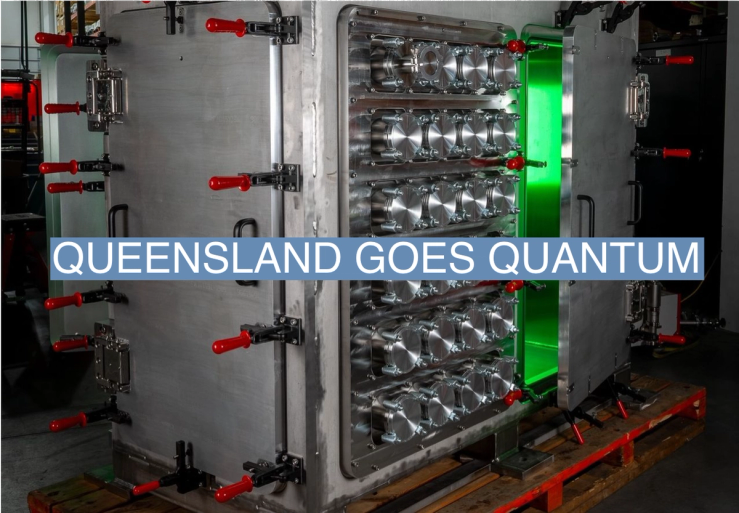The News
Silicon Valley startup PsiQuantum said Monday it secured $620 million from the Australian and Queensland governments to build the world’s first massive quantum computer there by the end of 2027.
PsiQuantum says the investment makes it the most heavily-funded quantum computing startup in the world, with $1.3 billion raised since it was founded in 2016. Other investors include Founders Fund, Playground Global and Redpoint Ventures.
Australia has been an early leader in quantum computing, investing in academic resources and establishing a national quantum strategy, with the goal of building commercially viable quantum computers in the country.
Pete Shadbolt, a PsiQuantum co-founder (two are from Australia) and its chief scientific officer, told Semafor that Australia picked his company because it was the most likely to reach a big enough scale to produce impactful results.
He noted the country has “spent a lot of money on research and they got a lot of amazing papers and a lot of amazing demonstrations. But it’s always been clear that in order to realize those benefits, you have to build a big, old, expensive machine.”
In this article:
Know More
Quantum computers do not work like traditional computers. Instead of using microscopic transistors, which can represent either ones or zeros, they use particles known as qubits.
Unlike transistors, qubits can exist in multiple states at a time, allowing them to perform different types of calculations. The theory of quantum entanglement allows many qubits to be linked, allowing for an even larger number of computations.
Traditional computers are more or less limited by the laws of classical physics; quantum computers are not.
There are several ways to make qubits, and popular methods include using trapped ions or particles within superconductors.
PsiQuantum believes the best approach is using individual photons as qubits, by manipulating single particles of light. While this is among the most difficult methods of quantum computing, PsiQuantum made a bet that it was ultimately the most practical for large scale quantum computers because of the existing infrastructure built around photonics.
It has partnered with one of the biggest semiconductor manufacturers in the world, Global Foundries, to produce photonic computers with enough fidelity to work with individual photons.
Another major advantage of using photons as qubits is that photons can operate at room temperature. Most other supercomputers require extremely cold temperatures, making them impractical at scale.
PsiQuantum’s method still requires refrigeration, but not nearly as much as other methods. As a result, it plans to build its quantum computers inside cryogenic cabinets built by a company that makes meat lockers.
Those units are then networked together to increase the total number of qubits. By the end of 2027, PsiQuantum plans to have a quantum computer with 1 million qubits. The largest quantum computers today have about 1,000.
With 1 million qubits, PsiQuantum believes it can perform error correction, essentially making up for mistakes made by the qubits. Traditional computers also require error correction, but in the case of quantum computers, the majority of qubits are used for this task. Shadbolt said “that sucks, but that’s tough luck.”
Networking the refrigerated units together was another hurdle for PsiQuantum. It needed to achieve a breakthrough in photonic switching, essentially sending photons back and forth with an unprecedented amount of fidelity, allowing very few photons to escape.
PsiQuantum revealed some of how it has achieved this in a paper that appeared online Friday.
Reed’s view
Australia’s willingness to bet on PsiQuantum’s ability to build a working quantum computer makes sense. Even if the company fails, the economic impact of attracting this kind of cutting edge technology will pay dividends in the long run.
When semiconductors were still nascent, Taiwan made a similar bet by subsidizing the development of TSMC. Now, the island is among the most technologically advanced areas in the world.
South Korea, the world’s leader in R&D as a percentage of GDP, has a similar story.
Australia, known more for mining than technology, stands to gain here.
If PsiQuantum is able to hit its target of a 1 million-qubit quantum computer by the end of 2027, then the next decade is going to see major, rapid technological development. Quantum computers will lead to immediate breakthroughs in materials science and biotechnology.
“We’re going to usher in, we hope, a new decade in which human beings have mastery over chemistry and physics of the type they’ve not had before,” Shadbolt said.
Room for Disagreement
In Australia, there’s some pushback on the government’s willingness to bet big on a foreign company, even if it has some Australian DNA. James Riley of InnovationAus.com wrote: “The idea that Australia, having spent tens of millions of public research dollars on quantum research over decades, would drop $200 million or more on a foreign quantum startup that has made no investment in this country and no commitment to this country seems unhinged.
For Australia’s quantum companies, it would be a disaster. It would have a crippling effect on the ability of Australia’s quantum hardware pioneers’ ability to raise venture capital in international markets.
Every conversation with the specialist quantum VCs in the world would start with trying to explain why your own government would make a signature NRF or Future Made in Australia investment into a US company, rather than any kind of investment in your own company.”
Notable
- It’s not easy to write about quantum computing, in part because the technology is so far out there. This Forbes article goes deep on PsiQuantum’s various challenges it needs to overcome before it can scale its quantum computer.


